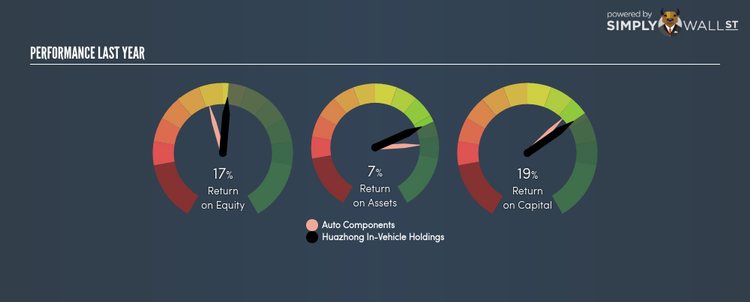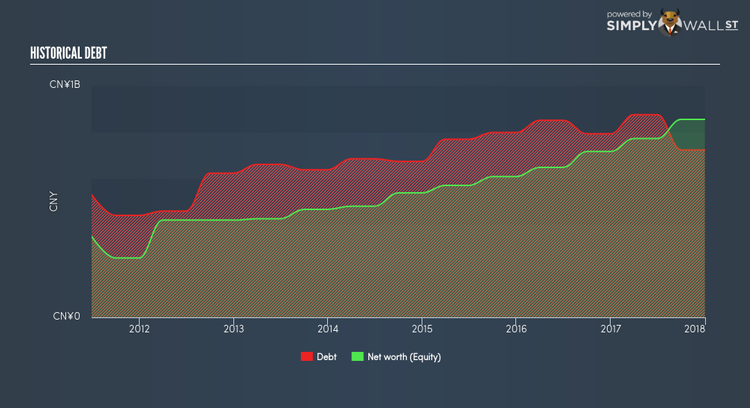Can Huazhong In-Vehicle Holdings Company Limited’s (HKG:6830) ROE Continue To Surpass The Industry Average?

With an ROE of 16.77%, Huazhong In-Vehicle Holdings Company Limited (SEHK:6830) outpaced its own industry which delivered a less exciting 13.46% over the past year. Superficially, this looks great since we know that 6830 has generated big profits with little equity capital; however, ROE doesn’t tell us how much 6830 has borrowed in debt. In this article, we’ll closely examine some factors like financial leverage to evaluate the sustainability of 6830’s ROE. See our latest analysis for Huazhong In-Vehicle Holdings
Breaking down ROE — the mother of all ratios
Return on Equity (ROE) weighs Huazhong In-Vehicle Holdings’s profit against the level of its shareholders’ equity. For example, if the company invests HK$1 in the form of equity, it will generate HK$0.17 in earnings from this. Generally speaking, a higher ROE is preferred; however, there are other factors we must also consider before making any conclusions.
Return on Equity = Net Profit ÷ Shareholders Equity
ROE is assessed against cost of equity, which is measured using the Capital Asset Pricing Model (CAPM) – but let’s not dive into the details of that today. For now, let’s just look at the cost of equity number for Huazhong In-Vehicle Holdings, which is 10.95%. This means Huazhong In-Vehicle Holdings returns enough to cover its own cost of equity, with a buffer of 5.82%. This sustainable practice implies that the company pays less for its capital than what it generates in return. ROE can be dissected into three distinct ratios: net profit margin, asset turnover, and financial leverage. This is called the Dupont Formula:
Dupont Formula
ROE = profit margin × asset turnover × financial leverage
ROE = (annual net profit ÷ sales) × (sales ÷ assets) × (assets ÷ shareholders’ equity)
ROE = annual net profit ÷ shareholders’ equity
The first component is profit margin, which measures how much of sales is retained after the company pays for all its expenses. Asset turnover reveals how much revenue can be generated from Huazhong In-Vehicle Holdings’s asset base. And finally, financial leverage is simply how much of assets are funded by equity, which exhibits how sustainable the company’s capital structure is. Since ROE can be artificially increased through excessive borrowing, we should check Huazhong In-Vehicle Holdings’s historic debt-to-equity ratio. The debt-to-equity ratio currently stands at a sensible 84.58%, meaning the above-average ROE is due to its capacity to produce profit growth without a huge debt burden.
Next Steps:
While ROE is a relatively simple calculation, it can be broken down into different ratios, each telling a different story about the strengths and weaknesses of a company. Huazhong In-Vehicle Holdings’s above-industry ROE is encouraging, and is also in excess of its cost of equity. ROE is not likely to be inflated by excessive debt funding, giving shareholders more conviction in the sustainability of high returns. ROE is a helpful signal, but it is definitely not sufficient on its own to make an investment decision.
For Huazhong In-Vehicle Holdings, I’ve compiled three pertinent factors you should further examine:
Financial Health: Does it have a healthy balance sheet? Take a look at our free balance sheet analysis with six simple checks on key factors like leverage and risk.
Future Earnings: How does Huazhong In-Vehicle Holdings’s growth rate compare to its peers and the wider market? Dig deeper into the analyst consensus number for the upcoming years by interacting with our free analyst growth expectation chart.
Other High-Growth Alternatives : Are there other high-growth stocks you could be holding instead of Huazhong In-Vehicle Holdings? Explore our interactive list of stocks with large growth potential to get an idea of what else is out there you may be missing!
To help readers see pass the short term volatility of the financial market, we aim to bring you a long-term focused research analysis purely driven by fundamental data. Note that our analysis does not factor in the latest price sensitive company announcements.
The author is an independent contributor and at the time of publication had no position in the stocks mentioned.

 Yahoo Finance
Yahoo Finance 

